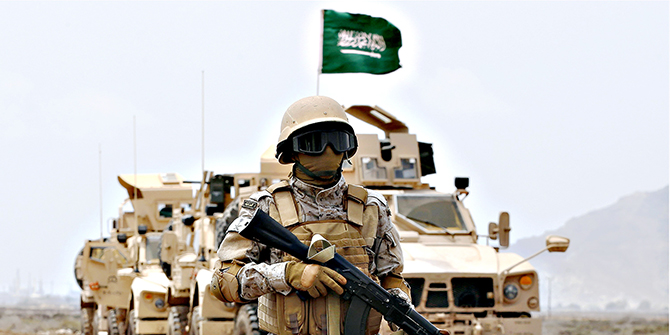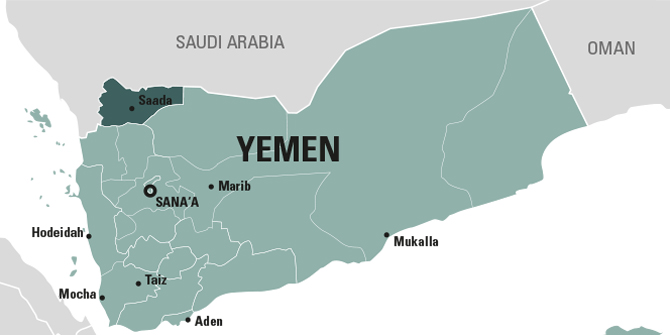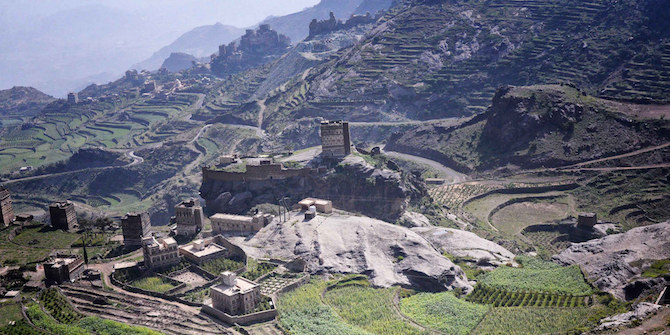by Gabriele vom Bruck
#LSEYemen
This memo was presented at a workshop on ‘Yemen’s Urban–Rural Divide and the Ultra-Localisation of the Civil War‘ organised by the LSE Middle East Centre on 29 March 2017.

The Ottomans conquered the northern town of Saada in the mid-19th century and left it unscathed. By contrast, in the Saudi military campaign that began a century and half later most of it has been destroyed. Saada province has witnessed the most intense destruction of rural livelihoods of anywhere in Yemen. The Saudi-led coalition has decimated viable farming communities tied by kinship and mutual religious and economic interests – many of them already severely damaged by the previous wars (2004–2010). Following Trump’s election victory, the coalition has continued to use cluster bombs in spite of an earlier declaration that it would refrain from doing so. In mid-March these bombs targeted streets, markets, and remote villages in Saada which could not be reached by ambulances. As elsewhere in northern Yemen, Saudi air force followed this course in the hope that the local population would rise against the Huthis; in seeking to undermine the Huthis’ support base in Saada, it has wiped out much of its civilian infrastructure.
Shortly after Saudi Arabia’s devastating bombardment of a funeral hall in San‘a in October 2016, which killed more than a hundred people, the coalition and their allied Yemeni fighters opened a new front in Saada province.
Briefly contextualising this recent development, note that over the past decades both Saudi Arabia and Ali Abdullah Saleh, by sponsoring Salafi-Wahhabi teaching centres and using Sunni Islamists for their own political ends, sought to weaken the Zaydi elites and their socialist rivals. In the 1980s, a Zaydi revival movement emerged in Saada in response to those policies. Both the Yemeni and Saudi armies were concerned to suppress it. One of the problematic decisions taken by Saleh’s government was to rely on fighters of both the Hashid confederation and Sunni jihadis. After the uprising against Saleh’s regime in 2011, fighting began between the Huthis and the inhabitants of the Dar al Hadith in Dammaj, a Salafi centre near Saada city, which also involved Hashid who had pledged to defend the latter’s interests. Subsequently those tribal fighters and Islamist paramilitaries – who had already aided the army during the war of 1994 between northern and southern forces and during the Saada wars – again fought the Huthis in 2013–14.
Following government mediation, the Dammaj centre was closed in 2014. Some of its defenders who were obliged to leave Saada have returned to the northern region, this time under Saudi Arabia’s banner. The composition of the fighting force and the timing of the recent offensive in Yemen’s border region demonstrate a sectarian war in the making, and there are likely to be both local and regional ramifications.

The attack began on Ashura in October 2016. At the start of the campaign, fighters crossed into Yemen from Najran and, after taking the border town of Buq‘a, headed towards Kutaf. Like Dammaj, Kutaf used to host a Salafi madrasa which became a major centre of anti-Shiʿi agitation, attracting students from all over the world. It was sheltered by members of the Wa’ila tribe. Some of its members have adopted Salafi-Wahhabi Islam. The centre in Kutaf had once been an army base run by the so-called ‘Afghan Arabs’ who were later joined by other jihadis who became mercenaries in the Saada wars.
The Saudi army has recruited Yemeni tribal leaders with anti-Shiʿi leanings, among them the Wa’ila, who were defeated by the Huthis in the 5th and 6th Saada wars and had subsequently fled to Marib and Najran and have been asking to join coalition forces for some time. The cycles of revenge are thus destined to continue. Whilst all groups involved in the conflict are claiming to be ‘protecting the faith’, retribution seems to be a powerful motive. Angered by their expulsion from Dammaj and Kutaf, the Salafis re-grouped in Taiz and Aden where they fought against the Huthis. They are now participating in the offensive against Saada, which by March 2017 was under Huthi control. There has been speculation that Ansar Shari‘a (AQAP) fighters who were evacuated from Mukalla in April 2016 are also taking part. As noted by Michael Horton, senior analyst at the Jamestown foundation,
‘As some of the best-trained, best-equipped, and most disciplined fighters, AQAP operatives are often invaluable to forces who are fighting the Houthis.’
The recent cross-border offensive in Saada has met stiff resistance from local forces. Many of the fighters who were sent from Aden to join other anti-Huthi fighters were killed or captured. This has created significant divisions among coalition forces. A northern commander who had asked the southern fighters to withdraw from a hill where they were stationed was accused of having betrayed them by exposing them to enemy fire.
President Hadi’s recent appointments in 2016 are not likely to promote reconciliation in the province. He assigned a Wa’ila tribesman, Hadi Tirshan al-Wa’ili, as governor of Saada. He has of late shown himself to be a dedicated Salafi. Uthman Mujalli, a local shaykh and patron of the Salafi centres, acts as an advisor to the president.
The involvement of radical Salafi groups in the latest incursion into the Zaydi heartlands suggests that the coalition may have goals beyond defeating the Huthis. Over the past forty years, the Saudi government has invested heavily in Salafi-Wahhabi-style madrasas and mosques in the northern areas, only to realise that this programme was jeopardised by the Zaydi revival movement. If the Huthis were to be defeated in their home province, it is likely that the Salafi-Wahhabi programme will be revived, and implemented more fiercely than in previous years. By destabilising the social and religious networks in the area, the Huthis’ foes are hoping to eliminate the residual power of the Zaydi elites.
It is not only Zaydi Islam, a doctrine that has been anchored in Yemen for over a millennium, which is at stake in this war, but also Muhammad b. Salman’s prestige and legitimacy, and a possible future claim to the throne. He may seek to model himself on his grandfather who expanded his emirate westwards. If the young prince were able to expand the Wahhabi da`wah southwards, he could legitimise himself in the eyes of the ulama, the traditional kingmakers who are suspicious of the ‘fun’ elements of his Vision 2030.
However, Saudi Arabia’s strategy may backfire. The Wahhabi da`wah is a manifestation of the hegemonic claims of a major regional power which seeks to demonstrate the success of its dynasty partly by disseminating its version of Islam in the old Zaydi heartlands – particularly after its failure to build influence in Iraq and Syria via Islamist groups. Although Saudi Arabia’s religious nationalism is akin to the ideologies professed by some of the groups which are currently taking part in the assault on Saada, it is taking a risk by gathering them at its border and providing them with sophisticated weapons. The scenario we currently find in Taiz – where a considerable number of militant groups stuck in a deadlock are fighting each other – may repeat itself in the border region, and there may be a blowback in the future as these groups aspire to be ruled by an amir rather than a monarch.
Dr Gabriele vom Bruck is Senior Lecturer in the Social Anthropology of the Middle East in the Department of Anthropology and Sociology, SOAS.
Other Contributions in the Series
- Yemen’s Rural Population: Ignored in an Already-Forgotten War, Helen Lackner
- Empire of Information: The War on Yemen and its Agricultural Sector, Martha Mundy
- The Battle to Control the ‘Commanding Heights’ of the Yemeni Economy, Rafat Al-Akhali
- From Protesters to Politicians: The Rise of the Houthis, Nawal Al-Maghafi
- Taiz Youth: Between Conflict and Political Participation, Maged Sultan
- Community Responses to Conflict in Taiz, Kate Nevens
- Healthcare under Siege in Taiz, Sophie Désoulières
- Aden: Relief Challenges and Opportunities, Awssan Kamal
- Marib: Local Changes and the Impact on the Future of Yemeni Politics, Alkhatab Al-Rawhani
- Hadhramout from Federalism to Civil War: Demands and Realities, Baraa Shiban







To start at the end: what exactly is the difference between an amir and a monarch?